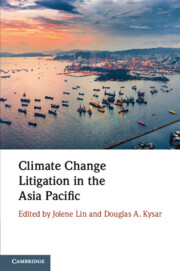60 results
9 - The Farmer or the Hero Litigator?
- from Part II - Legal Strategy in Rights-Based Climate Litigation
-
-
- Book:
- Litigating the Climate Emergency
- Published online:
- 10 November 2022
- Print publication:
- 03 November 2022, pp 187-205
-
- Chapter
-
- You have access
- Open access
- HTML
- Export citation
Abbreviations
-
- Book:
- Climate Change Litigation in the Asia Pacific
- Published online:
- 06 November 2020
- Print publication:
- 29 October 2020, pp xiv-xvi
-
- Chapter
- Export citation
Tables
-
- Book:
- Climate Change Litigation in the Asia Pacific
- Published online:
- 06 November 2020
- Print publication:
- 29 October 2020, pp viii-viii
-
- Chapter
- Export citation
Part II - International Law and International Adjudication
-
- Book:
- Climate Change Litigation in the Asia Pacific
- Published online:
- 06 November 2020
- Print publication:
- 29 October 2020, pp 71-172
-
- Chapter
- Export citation
Part IV - China, Courts and Climate Change
-
- Book:
- Climate Change Litigation in the Asia Pacific
- Published online:
- 06 November 2020
- Print publication:
- 29 October 2020, pp 329-415
-
- Chapter
- Export citation
Contents
-
- Book:
- Climate Change Litigation in the Asia Pacific
- Published online:
- 06 November 2020
- Print publication:
- 29 October 2020, pp v-vi
-
- Chapter
- Export citation
Contributors
-
- Book:
- Climate Change Litigation in the Asia Pacific
- Published online:
- 06 November 2020
- Print publication:
- 29 October 2020, pp ix-x
-
- Chapter
- Export citation
Foreword
-
- Book:
- Climate Change Litigation in the Asia Pacific
- Published online:
- 06 November 2020
- Print publication:
- 29 October 2020, pp xi-xiii
-
- Chapter
- Export citation
Part III - Domestic Law and Domestic Adjudication
-
- Book:
- Climate Change Litigation in the Asia Pacific
- Published online:
- 06 November 2020
- Print publication:
- 29 October 2020, pp 173-328
-
- Chapter
- Export citation
Figures
-
- Book:
- Climate Change Litigation in the Asia Pacific
- Published online:
- 06 November 2020
- Print publication:
- 29 October 2020, pp vii-vii
-
- Chapter
- Export citation
Index
-
- Book:
- Climate Change Litigation in the Asia Pacific
- Published online:
- 06 November 2020
- Print publication:
- 29 October 2020, pp 416-428
-
- Chapter
- Export citation
11 - Climate Change Adaptation Litigation: A View from Southeast Asia
- from Part III - Domestic Law and Domestic Adjudication
-
-
- Book:
- Climate Change Litigation in the Asia Pacific
- Published online:
- 06 November 2020
- Print publication:
- 29 October 2020, pp 294-328
-
- Chapter
- Export citation
Introduction
-
-
- Book:
- Climate Change Litigation in the Asia Pacific
- Published online:
- 06 November 2020
- Print publication:
- 29 October 2020, pp 1-12
-
- Chapter
- Export citation
Copyright page
-
- Book:
- Climate Change Litigation in the Asia Pacific
- Published online:
- 06 November 2020
- Print publication:
- 29 October 2020, pp iv-iv
-
- Chapter
- Export citation
Part I - Theoretical Underpinnings and Implications of Climate Change Litigation
-
- Book:
- Climate Change Litigation in the Asia Pacific
- Published online:
- 06 November 2020
- Print publication:
- 29 October 2020, pp 13-70
-
- Chapter
- Export citation

Climate Change Litigation in the Asia Pacific
-
- Published online:
- 06 November 2020
- Print publication:
- 29 October 2020
The Emergence of Climate Litigation in the Global South
-
- Journal:
- Proceedings of the ASIL Annual Meeting / Volume 114 / 2020
- Published online by Cambridge University Press:
- 01 March 2021, pp. 85-86
- Print publication:
- 2020
-
- Article
- Export citation
Transnational Climate Litigation: The Contribution of the Global South
-
- Journal:
- American Journal of International Law / Volume 113 / Issue 4 / October 2019
- Published online by Cambridge University Press:
- 26 June 2019, pp. 679-726
- Print publication:
- October 2019
-
- Article
-
- You have access
- HTML
- Export citation
Abbreviations
-
- Book:
- Governing Climate Change
- Published online:
- 04 June 2018
- Print publication:
- 21 June 2018, pp viii-viii
-
- Chapter
- Export citation
3 - The Rise of the City in International Affairs
-
- Book:
- Governing Climate Change
- Published online:
- 04 June 2018
- Print publication:
- 21 June 2018, pp 42-69
-
- Chapter
- Export citation



